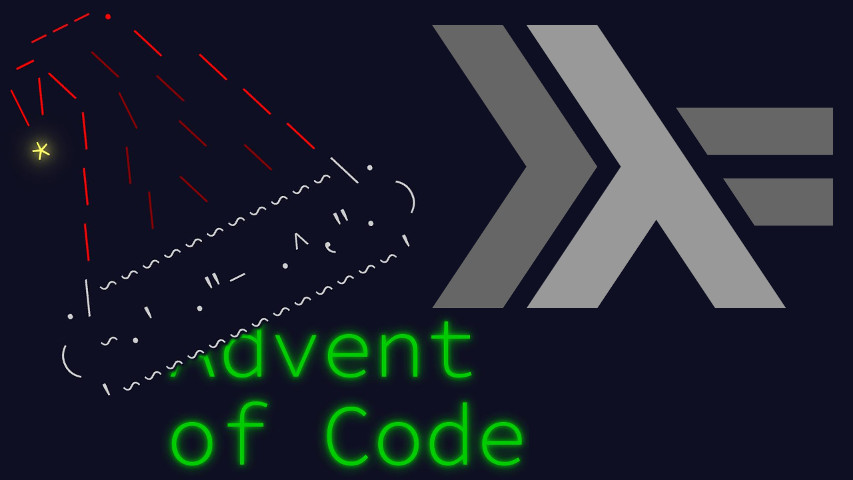Today’s Advent of Code puzzle, “Unstable Diffusion”, is the cellular automaton of the year. Cells on a grid are either elven or dead, and evolve according to a simple pattern.
This is literate Haskell because I wouldn’t want to upset anyone by now, and it starts with a few imports.
import Control.Arrow ((&&&))
import Control.Lens (view)
import Linear (V2(V2),_x,_y)
import Data.List (elemIndex,find)
import Data.Maybe (catMaybes)
import Data.Map.Strict (Map)
import qualified Data.Map.Strict as Map
import Data.Set (Set)
import qualified Data.Set as SetSo we have a set of elves again. I’ll represent them with their 2D positions.
type V = V2 IntParsing is just labeling each hash mark in the input with its coordinates.
parse :: String -> Set.Set V
parse = Set.fromList . concat . zipWith row [0..] . lines where
row i = catMaybes . zipWith (col i) [0..]
col i j '#' = Just (V2 i j)
col _ _ _ = NothingThe diffusion we’re managing today has a few simple rules. I’m mostly following them, I’ll only allow myself a little twist to make my life easier: whereas the statement says if an elf is isolated, they don’t move, I’m instead expressing it as if isolated elves proposed a “stay in place” move.
Why doesn’t it change anything? When moves are resolved in phase 2, only moves where the target doesn’t collide get performed. Moving to the current place is the same as not moving, but what about the influence on elves that attempt to move to the same place? It turns out there can’t be any, as move proposals only happen when there’s nobody in that general direction.
So let’s implement that. We’re computing the set of elf positions after turn i, considering the former set of elf positions.
step :: Set V -> Int -> Set V
step cur i = next whereEach elf proposes its next position. As mentioned earlier, an isolated elf, i.e. one with no neighbors, proposes to remain in place. The others go in the first cardinal direction from their preference list with no one nearby, be it directly in that direction or diagonally.
proposal from
| all ((`Set.notMember` cur) . (from +)) neighbors = from
| otherwise = maybe from head $
find (all (`Set.notMember` cur)) $
(map . map) (from +) attemptsPreferred direction cycles per turn.
attempts0 =
[ [ V2 (-1) 0, V2 (-1) 1, V2 (-1) (-1) ]
, [ V2 1 0, V2 1 1, V2 1 (-1) ]
, [ V2 0 (-1), V2 (-1) (-1), V2 1 (-1) ]
, [ V2 0 1, V2 (-1) 1, V2 1 1 ]
]
(al,ar) = splitAt (i `mod` 4) attempts0
attempts = ar ++ alLet’s compute proposed position for each elf and store that in a map.
proposals = Map.fromSet proposal curBetween phases 1 and 2, we check for conflicts. A conflict is a cell two1 elves want to move to during the same turn.
conflicts = Map.filter (> 1) $ Map.fromListWith (+) $
zip (Map.elems proposals) (repeat 1)The actual movement thus only happens in absence of conflict.
move from prop = if prop `Map.member` conflicts then from else propAnd we can compute the global next set.
next = Set.fromList $ Map.elems $ Map.mapWithKey move proposalsThe set of neighbors is a constant.
neighbors :: [V]
neighbors =
[ V2 (-1) (-1), V2 (-1) 0, V2 (-1) 1
, V2 0 (-1), V2 0 1
, V2 1 (-1), V2 1 0, V2 1 1
]Running the entire simulation is then a simple matter of repeatedly
invoking the step function on an infinite list of turn
indices.
run :: Set V -> [Set V]
run = flip (scanl step) [0..]For part 1, we’re asked for an arbitrary checksum of the final position’s span.
checksum :: Set V -> Int
checksum s = (imax - imin + 1) * (jmax - jmin + 1) - Set.size s
where
imin = minimum (view _x <$> Set.elems s)
imax = maximum (view _x <$> Set.elems s)
jmin = minimum (view _y <$> Set.elems s)
jmax = maximum (view _y <$> Set.elems s)
part1 :: Set V -> Int
part1 = checksum . (!! 10) . runFor part 2, we merely time stability.
part2 :: Set V -> Maybe Int
part2 = fmap succ . elemIndex True . (zipWith (==) =<< tail) . runAnd that’s it!
main :: IO ()
main = interact $ show . (part1 &&& part2) . parseThis concludes today’s solution. See you tomorrow!
Theoretically, or more, but it can’t happen here.↩︎



